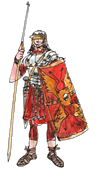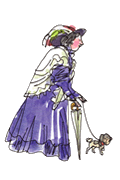Norman / Medieval
The Norman period in Britain started when William of Normandy (William the Conqueror) beat King Harold of England at the Battle of Hastings in 1066.
William then became King William I of England and he gave pieces of land in England to his lords. The lords that lived near the borders of Wales were very powerful and wanted to make the land they owned bigger. They began to build castles in Wales to use to control and protect their land.
The Norman invasion of Wales really started soon after they had conquered England but they didn’t properly invade until 1081.
People often talk about the “Middle Ages” or “Medieval Period”. This is usually the time after the Romans left to about the time of the Tudors so the Norman period is included in those times.
Use the 'Next' arrow to discover more about this historic period.
The Castle
When the Normans came to Cardiff, they found the remains of the last Roman fort and built a wooden motte and bailey castle here.
The Castle was on top of a large hill (the “motte”). Around the bottom of the motte was the “bailey” where there would have been extra accommodation and buildings including the kitchens and stables.
By around 1135, the wooden Castle was replaced with a stronger, stone “keep”. The Keep had 12 sides and did not have a roof. Inside there would have been wooden buildings.
By this time, it is likely that there were more buildings inside the bailey for the extra people who lived and worked there.
In the 13th century, the Black Tower near the main entrance was built by the de Clare family who owned the Castle at the time. They later went on to build Caerphilly Castle which is near Cardiff.
In 1423, the Castle was owned by Richard de Beauchamp who built Warwick Castle. He built a new accommodation and a tower which now forms the middle part of the House at Cardiff Castle.
See how the castle has changed over time
Use the 'Next' arrow to discover more about this historic period.
Who ruled at the time
Use the 'Next' arrow to discover more about this historic period.
Cardiff
If you were a Norman knight arriving in Cardiff in 1081, you would have found a very small, quiet town and lots of empty fields.
Once the Castle was built, more and more buildings would have appeared around it. Many of these would have been used by craftsmen and traders who wanted to sell their goods to the Norman lords.
These buildings would have had thatched roofs and would have been made from “Wattle and Daub”. Find out what Gwen the Celtic girl has to say about Wattle and Daub.
There were churches and chapels built in the town and two monasteries were near the Castle. The remains of one of them called can still be seen in Bute Park, behind the Castle.
As in the Roman times, the river was far nearer the Castle than it is today and there were several wooden bridges over it for people to enter the town. On the side of the moat just behind the Castle was a mill which would have provided flour for the local people.
















